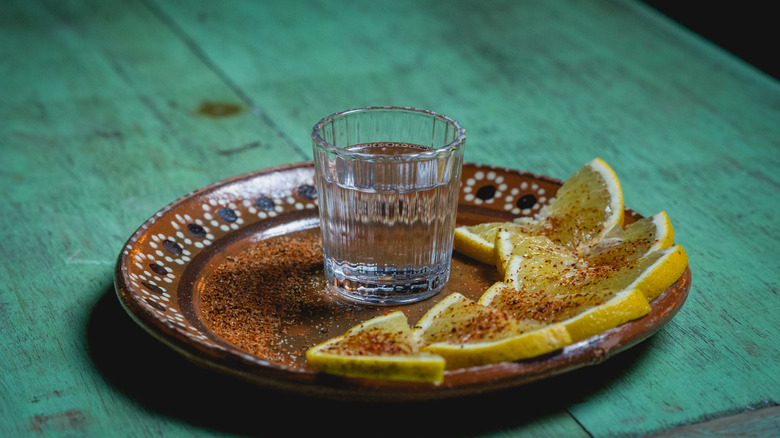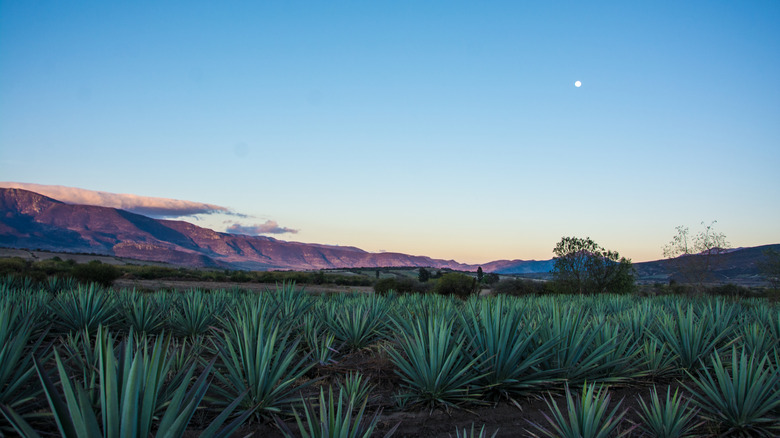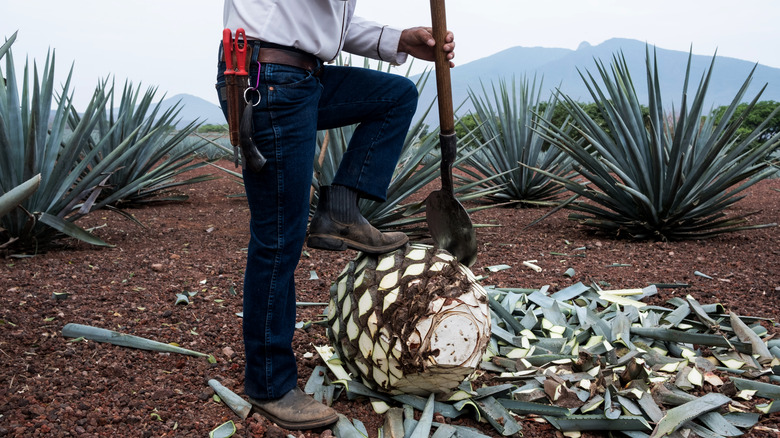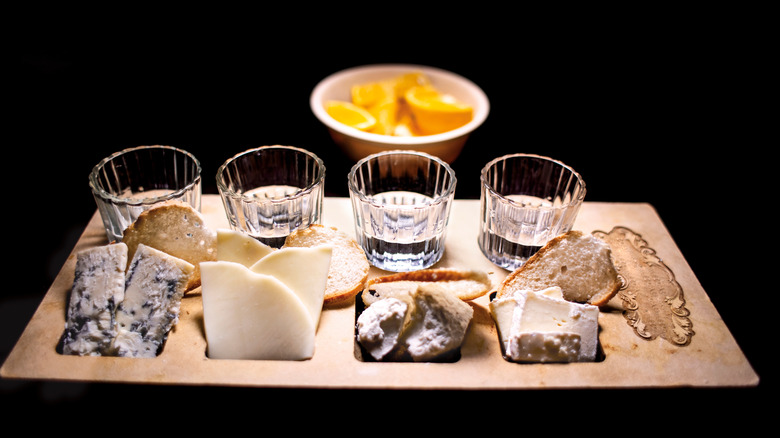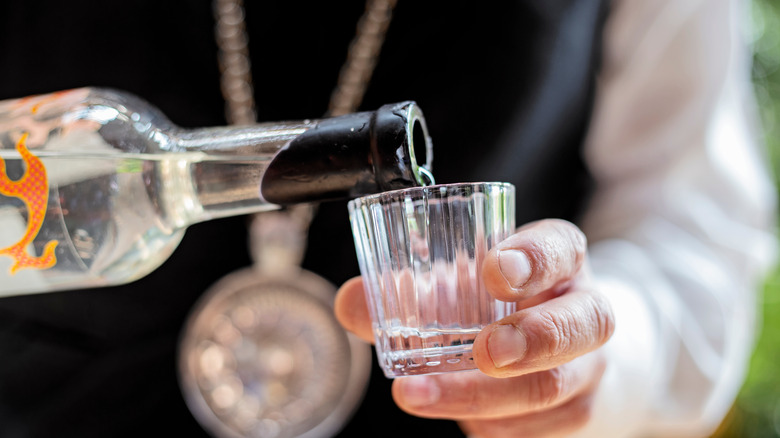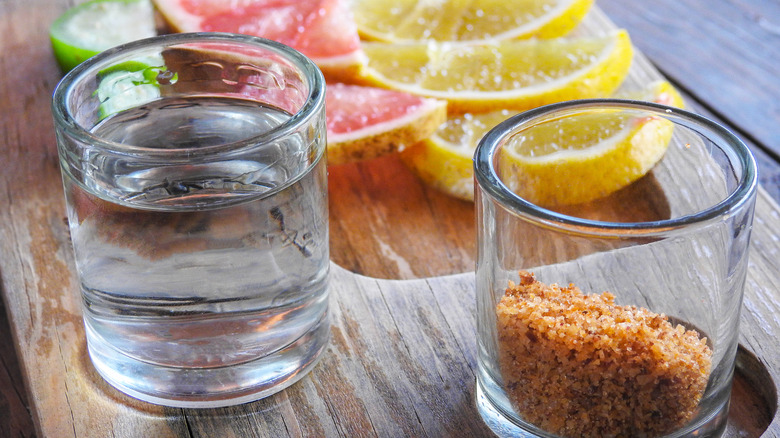Everything You Need To Know About Mezcal
While it may be less well known than its cousin tequila, mezcal has been steadily making its way into bars and liquor cabinets over the years. It's a distilled alcoholic beverage made from agave, but unlike the smoother taste of tequila, mezcal has a smoky finish.
If it seems like you're coming across more mezcal than ever, it's not just your imagination. Recently, the U.S. market for mezcal outgrew the one in Mexico. According to Shanken News, even though mezcal still does not enjoy the recognition of tequila, 71% of its exports go to the United States. In terms of pure amount, the United States received 371,000 9-liter cases of the spirits while only 304,000 were distributed throughout Mexico. The relative surge in popularity ties to the demographic outlined by Mezcalistas: millennials and Gen-Xers.
Perfect on its own and essential in many cocktails, mezcal seems set to become the new gin. So, we should really learn more about tequila's less popular relative.
Dawn of mezcal
We first hear of mezcal, as The Daily Meal explains, 400 years ago when the Spanish conquistadors brought distillation techniques to Mexico and applied them to the local agave as a substitute for the lack of vines.
Obviously, though, people had discovered the intoxicating effects of agave long beforehand. Great Agave describes how centuries upon centuries prior to the arrival of the Spanish, the plant was considered sacred and was given its own divine personification called Mayahuel, goddess of fertility and nourishment and mother to Centzon Tōtōchtin, the 400 rabbits of intoxication.
In that spirit, another agave-based intoxicant was produced called pulque, which you can still enjoy today. The difference between pulque and mezcal is that the former develops from fermentation while the latter is produced with distillation. Because of the distillation process involved with a plant already used for getting drunk, the name mezcal comes, from the Nahuatl words metl and ixcalli, "overcooked agave," (via Gabbi Patrick).
How mezcal is made
Many agave varieties can be made into mezcal. However, that looseness overlooks the arduousness of the production. Durango, Guerrero, Guanajuato, Michoacán, Oaxaca, Puebla, San Luis Potosí, Tamaulipas, and Zacatecas are the Mexican states that are allowed to legally call their product mezcal. To produce the spirit, first, you need the actual agave to mature, an indefinite process that can extend from eight years to 30. If, however, the farmers take too long, they can miss the harvesting window and so have to wait another decade or so before they can reap their crop. After harvesting, another crop has to mature, per Serious Eats.
Then comes the actual retrieval of the piña, the heart of the plant from which the mezcal is distilled. To get to it, farmers must hack away the leaves that surround the agave. To top it off, it takes more than one piña to produce a batch of mezcal.
According to Gourmet Traveller, after the fetching of the piñas, mezcaleros, the distillers, build a fire and let it reduce to a simmering coal mass. The mezcaleros place the piñas around this mass, cover them with leaves and dirt, and leave them to roast. After roasting, they mash the piñas and leave the extracted juices within a giant tank. The process ends with a pretty straightforward distillation. Except in mezcal's case, the distillation occurs within a pot made of copper, clay, or wood.
The most common type of mezcal produced is espadín, which accounts for 90% of production and has a versatile taste, per Food Republic.
The difference between tequila and mezcal
Some may wonder here where the difference between mezcal and tequila arises. After all, both are Mexican spirits derived from agave. Wine Enthusiast Magazine draws the distinction for the uninitiated: tequila is a type of mezcal distilled from blue Weber agave, a specific subspecies of the plant. Tequila is also mainly produced in the Jalisco region of Mexico as well as some other municipalities (via CNBC). So, it is mostly a case of all squares are rectangles, but not all rectangles are squares. All tequilas are mezcal, but not all mezcals are tequila.
The other difference is that the production of tequila involves steaming the piña in an oven instead of fire roasting it. This is why anyone describing the taste of mezcal talks about its smokey flavor. Freude von Freuden, for example, waxes lyrical about the flavor: "As the alcoholic nectar coats the palate and then the throat in a silky liquid film, it evokes many complex nuances, with earth and smoke being the most readily identifiable ones."
How to enjoy mezcal
Unlike — say — sherry, mezcal does not traditionally serve as a gastronomic kicker to food. As Paste Magazine notes, if enjoying it authentically, it should be savored in its neatest form. Most mezcal is between 40 and 55 percent alcohol. That, however, does not prevent them from sharing four recipes that they believe would be improved upon by adding a splash of mezcal. In addition to noting that there is a chocolate sauce recipe from the Mexican state of Oaxaca, the one most famous for its mezcal, Paste includes the possibility of curing meat, using it in ceviche, and substituting tequila in a pan-roasted shrimp recipe with mezcal.
Most of that goes against the spirit in which the drink is drunk. However, in the United States, the country that buys the largest amount of mezcal, the drink has enjoyed its popularity as a cocktail spirit. So much so, in fact, that Imbibe Magazine had to limit themselves to 20 cocktail recipes for mezcal when searching for a favorite. Mezcal is commonly mixed with tropical fruits, hibiscus, and sometimes combined with other spirits in cocktails.
The prices for mezcal can easily be double or triple that of even an expensive tequila. This is primarily due to a combination of the small yield of an agave plant and the labor-intensive process involved in harvesting and distilling their piñas. For those kinds of prices, you probably do not want to splash it in your dishes willy-nilly.
Mezcal suffers from its own success
In the same year that mezcal's soaring popularity was reported, rumors also circulated that there was a possible shortage of mezcal and tequila. In 2020, Spirit Hunters explained that the surging popularity of the drinks threatened to drive the agave plant into extinction, or, at the very least, to put extreme stress upon a supply chain that featured a plant that takes at least eight years to mature.
Liquor.com's report attempts to calm such fears by learning that these periods of shortage were more cyclical than apocalyptic. "Tequila comes from a plant that's unlike, say, corn or grain, which can grow back every year. It takes seven to 10 years for an agave plant to grow," Jenna Fagnan, the president of Tequila Avión, told them.
However, talking to Gourmet Traveller, Alex Dowd and Jeremy Blackmore of Tio's Cerveceria lamented that the growing period of the agave that produces mezcals, which can last longer, puts it in greater danger of other environmental risks. Still, they too place the boom and bust cycle in the forefront and point to these shortages as another reason why a glass of mezcal could easily cost you $25 or $30.
